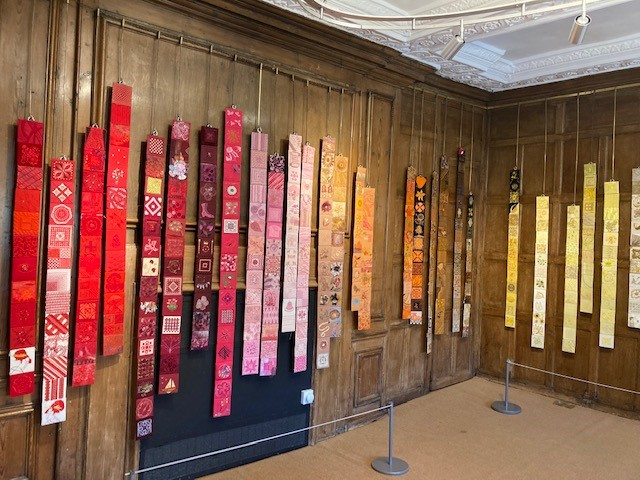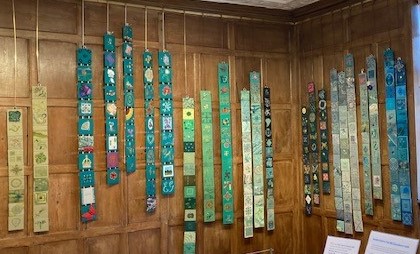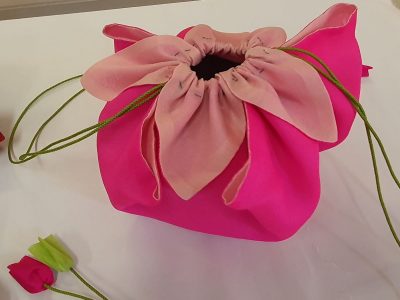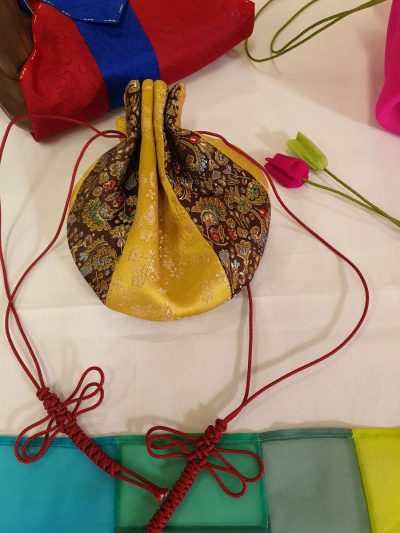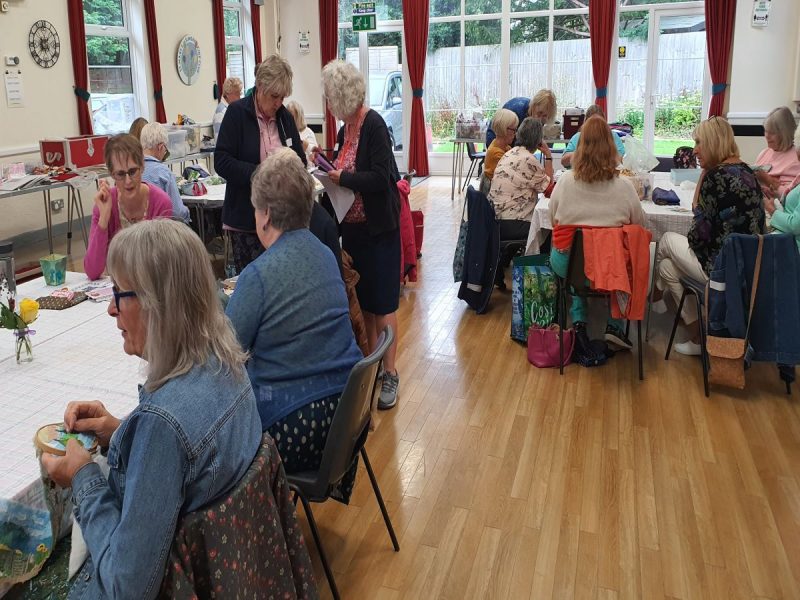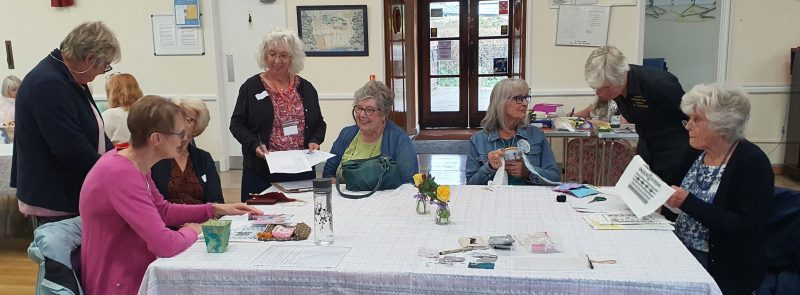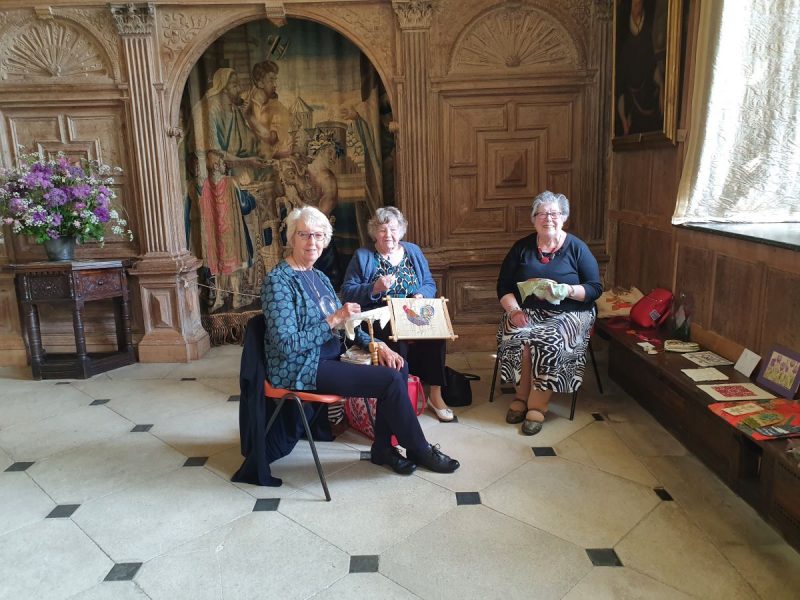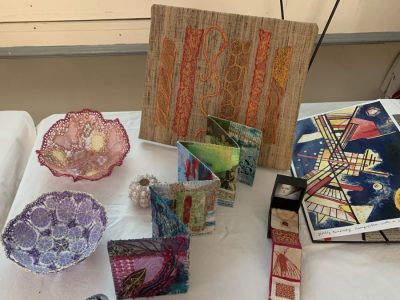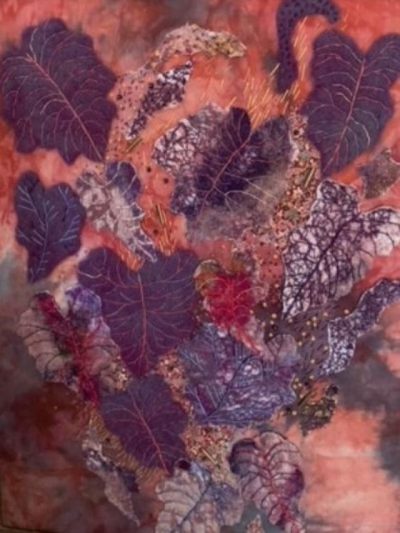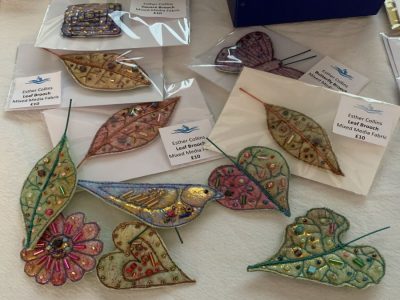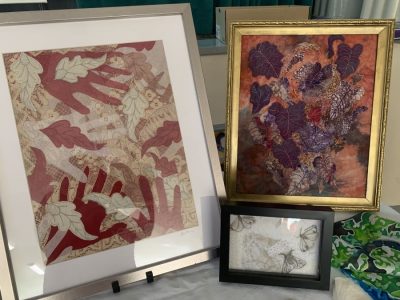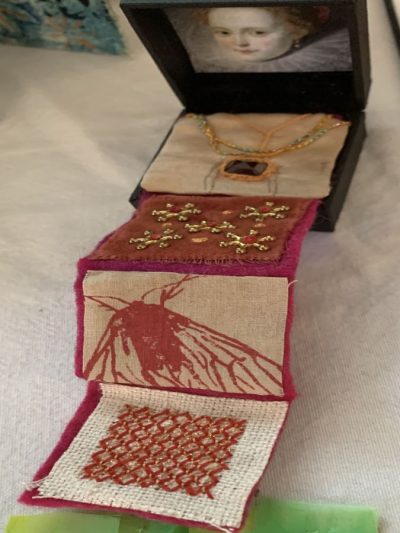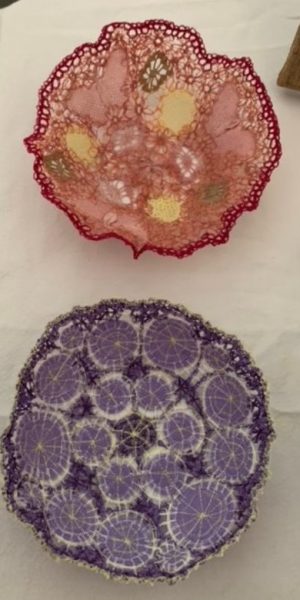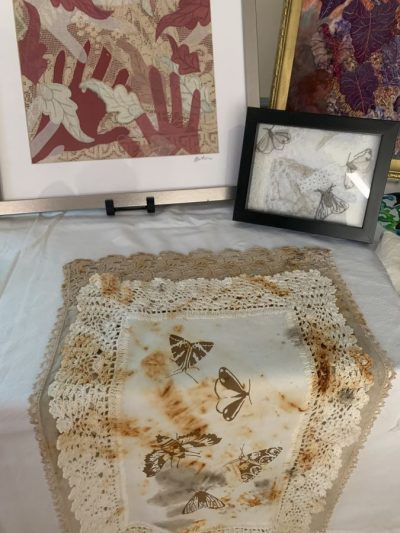 If you were a member way back when, you may have stitched one of these ‘Rainbow Squares’. It was a regional project where individual members of each group embroidered a square in the colour allocated to their group. They were then assembled in ‘chains’ and hung alongside the different colours from the other groups. You might like to know that they have been gathered together again, and exhibited at the Guildford House Gallery in Guildford (ours are the dark green ones). I saw them all together once a few years ago, and they look amazing in real life. You can see them there from today until to June 15th. It’s a long way to go, but Guildford is a nice place for shopping and a day out. Apologies for the quality of the photos (they lost quality through being emailed to me).
If you were a member way back when, you may have stitched one of these ‘Rainbow Squares’. It was a regional project where individual members of each group embroidered a square in the colour allocated to their group. They were then assembled in ‘chains’ and hung alongside the different colours from the other groups. You might like to know that they have been gathered together again, and exhibited at the Guildford House Gallery in Guildford (ours are the dark green ones). I saw them all together once a few years ago, and they look amazing in real life. You can see them there from today until to June 15th. It’s a long way to go, but Guildford is a nice place for shopping and a day out. Apologies for the quality of the photos (they lost quality through being emailed to me).
Tag: Southdowns Creative Stitchers
Textile treasures at Worthing museum
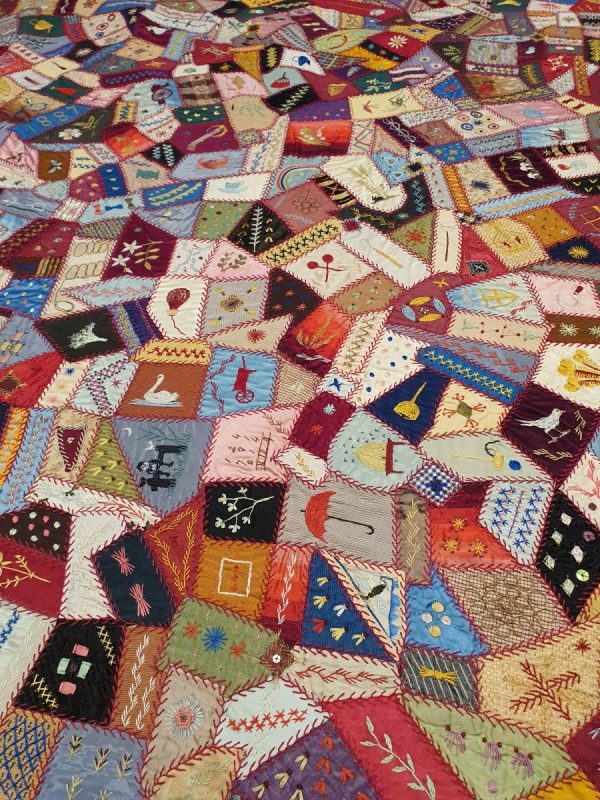
What a delightful morning we had at Worthing museum, enjoying a ‘show and tell’ session with Gerry Connelly, Head of Museums and Exhibitions. Gerry started his career in fashion design, before specialising in the History of Fashion. Gerry was the perfect person to show us some of the wonderful items that are owned by the museum but are not usually out on display.
Gerry started by showing us the oldest item in the collection, a blackwork jacket dating from 1610. It’s amazing that it is so well preserved.
We had a wonderful range of items to look at closely, and it’s lovely to see them without the reflections that you get when they’re behind glass. A couple of Elizabethan dress items: a fragment of embroidery that was probably originally on a jacket, and an embroidered glove that was probably given as a symbolic gift rather than for regular use, although it was interesting to see the signs of wear on the underneath.
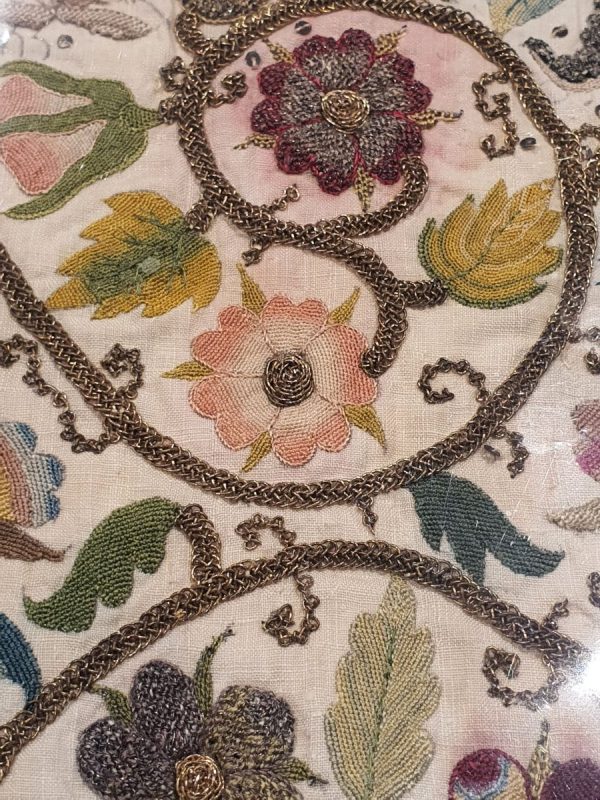


We saw a stunning embroidered waitcoat that could have come straight out of ‘The Tailor of Gloucester’ story, with stitching so fine that it could well have been stitched by mice.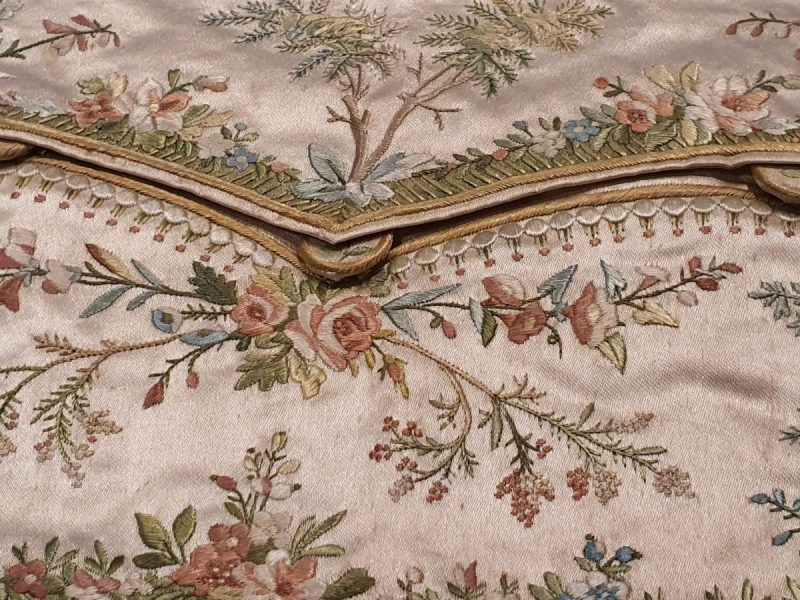
It was lovely to have time to study the details, and we could have happily stayed there all day.
Gerry brought out an embroidery called ‘The Warwick Street Embroidery’, which was stitched by our group in 2004. We had searched for it and no-one was sure where it was, but we were delighted to see that it is in the safe care of the museum. The embroidery was created by cutting up a historic photograph of Warwick Street, and distributing the cut-up rectangles to individual members to stitch. It was then re-assembled to re-create the picture. The names of the individual embroiderers were stitched on the back.


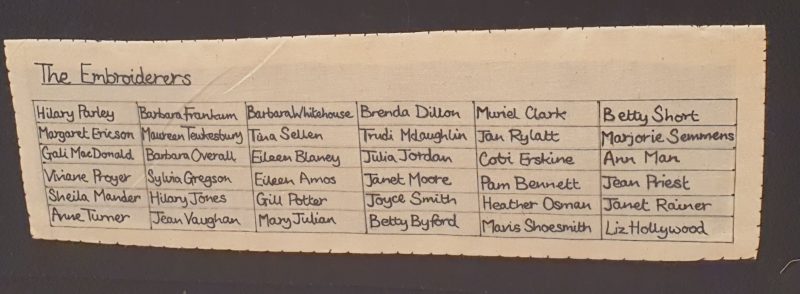
Lunch together afterwards was a lovely way to end the visit. Thanks to Chris for organising it all.
The Korean art of Bojagi
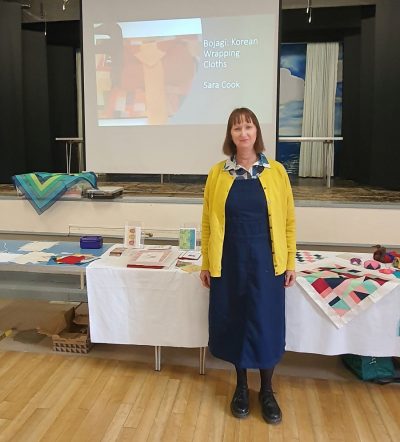
We had a fascinating talk this month by Sara Cook, on the Korean art of Bojagi. Sara is a quilter, tutor and quilting judge, who was drawn to this specialist technique after seeing an exhibition of Korean textiles. She was already an experienced quilter, and this particular technique caught her imagination straight away – so much so that she booked a trip to the Korean Bojagi Forum in 2016 (in Korea) to study it first-hand. Since then she has developed her own interpretation of this ancient technique and has taught the subject all over the world.
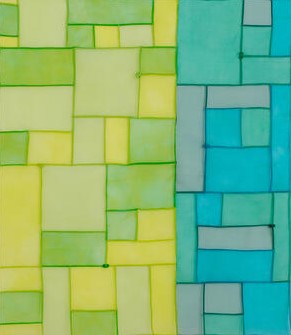
Bojagi originates from the art of wrapping, both for practical/functional reasons and also for decorative reasons such as giving presents. It was used for every-day use such as food storage, sometimes waxed to seal the food and keep it fresh. It was also used to store personal belongings, since space was at a premium and homes were cleared of personal items when they weren’t in use. Thicker layered cloths were made for warmth, usually from silk as it is warm in winter and cool in summer. Functional items could also be very decorative, like the heavily stitched thumbles below (the second photo is a thimble-making kit that you can buy via Sara’s website)
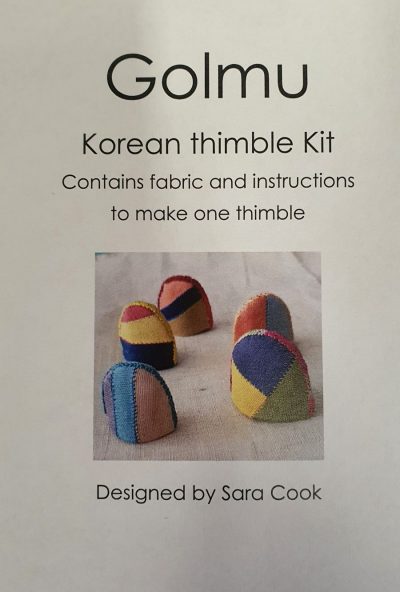
Sara spoke about the role of women in traditional Korean society. Women were expected to obey firstly their father, secondly their husband, and thirdly their son. Education was not permitted, and women could not leave the house without a male escort. When a woman married, she would leave her family home and would probably never see her family again, so the cloths made with her mother and sisters may have had particular significance in her new home. The giving of gifts was highly symbolic: for example ducks and geese, with blue and red to symbolise yin and yang.
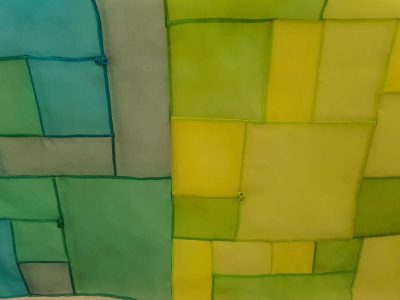
Korean cultural traditions changed significantly since occupation and the war years. The position of women has improved, but alongside that there ha been concern about losing cultural traditions as society modernises. Korea introduced an innovative cultural heritage programme. People with traditional skills are appointed as ‘national treasures’ and are given subsidised studios that enabled them to pass on their skills. This has led to techniques such as Bojagi being kept alive across the world. Sara has developed her own style of work using traditional Bojagi techniques. It involves a very particular and precise type of seam, and is worked to be hung against the light so that it’s translucent qualities are shown off to best advantage. You can see more of her work on her website at https://bojagiuk.com/
New art from old treasures
 Thanks to Chris for this description of Tuesday’s talk by Anne Kelly.
Thanks to Chris for this description of Tuesday’s talk by Anne Kelly.
‘Today we had an interesting talk from textile artist and Author Anne Kelly. Anne is resident artist at Sussex Prairie gardens and lots of our members have been there to workshops with her. Anne brought lots of examples of her unique style of art using paper, hand and machine embroidery and reclaimed fabrics. She is a well travelled artist, originating in Canada and putting on shows in Australia, France and India to name but a few places. She likes to exhibit her work in places like hospitals and hospices and not just art galleries. Anne does lots of commissions and likes working on old maps which she treats with PVA glue and tissue paper before stitching onto them. She feels strongly about reusing old fabrics and putting them to new use. Lots of her work had bits of old embroidery stitched into it. She has an exhibition in Hackney coming up’.
The details of Anne’s exhibition in October are in the poster below. Scroll down below that for lots of photos of the work that Anne brought with her to show the group, and there are more lovely things to look at on her website https://annekellytextiles.com/ 


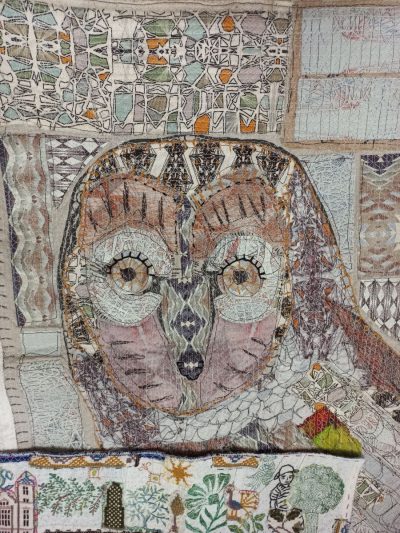

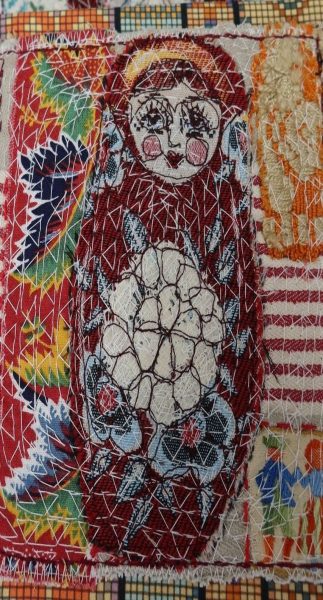




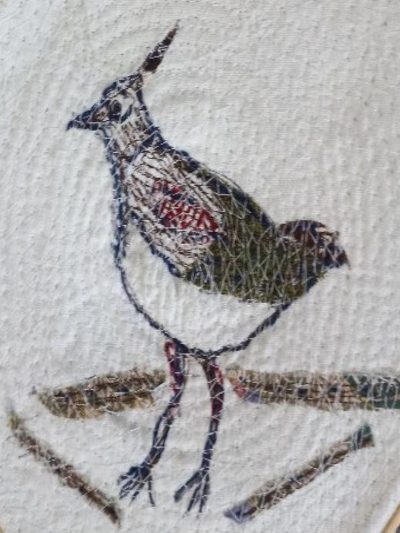

Tea and scones
 Instead of the summer picnic that we had for our August meeting in the last two years, this year we decided to have a catered ‘posh tea’ instead. This turned out to be a stroke of luck, given the wind and rain that afternoon. Thankfully we weren’t holding on to gazebos that were trying to take off into the field! Valerie kindly organised the caterer, as well as finishing touches such as floral tea cups and table-cloths. Thanks to Margaret for providing floral table-decorations (despite the fact that she was on her way to catch a flight). We were treated to scones with jam and cream, a selection of sandwiches, several different cakes, and strawberries and cream. Naughty but nice! There was a little bit of stitching before tea was served, but when sticky things appeared the sewing was mainly put away. Here are a selection of photos of us stitching beforehand, and then enjoying the feast. If anyone is looking for a cake-maker or caterer, she is Janet Spoor at ‘Janet’s celebration Cakes and Catering’.
Instead of the summer picnic that we had for our August meeting in the last two years, this year we decided to have a catered ‘posh tea’ instead. This turned out to be a stroke of luck, given the wind and rain that afternoon. Thankfully we weren’t holding on to gazebos that were trying to take off into the field! Valerie kindly organised the caterer, as well as finishing touches such as floral tea cups and table-cloths. Thanks to Margaret for providing floral table-decorations (despite the fact that she was on her way to catch a flight). We were treated to scones with jam and cream, a selection of sandwiches, several different cakes, and strawberries and cream. Naughty but nice! There was a little bit of stitching before tea was served, but when sticky things appeared the sewing was mainly put away. Here are a selection of photos of us stitching beforehand, and then enjoying the feast. If anyone is looking for a cake-maker or caterer, she is Janet Spoor at ‘Janet’s celebration Cakes and Catering’.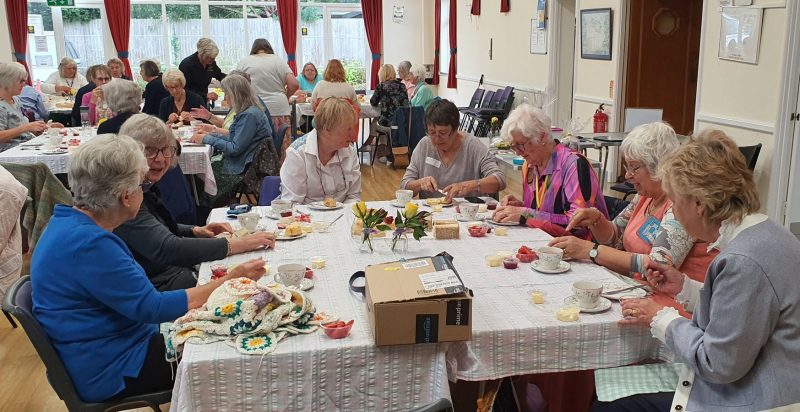

Parham House
Dustbin lids and cabbage leaves…
 Members enjoyed a fascinating and stimulating talk by textile artist Esther Collins at our June meeting. Esther is a local artist whose work is influenced by her interests in the History of Art, and also by her previous work in graphic design. Design influences include the natural environment, walking in the South Downs and local history.
Members enjoyed a fascinating and stimulating talk by textile artist Esther Collins at our June meeting. Esther is a local artist whose work is influenced by her interests in the History of Art, and also by her previous work in graphic design. Design influences include the natural environment, walking in the South Downs and local history.
I was so disappointed to miss Esther’s talk, and feedback from members has been very enthusiastic. Sadly I can’t add my own reflections on the talk as I usually do, but the talk generated appreciative comments from members, a couple of which I’ll add here: ‘I loved the leaf brooches and was inspired by the use of gold leaf in her decoupage work’ and ‘Esther produces beautiful work combining stitch, textiles and mixed media. I’ve never met any artist that gets inspiration from dustbin lids and cabbage leaves and then goes onto produce stunning pieces of creative work’. I’ll leave you with some images of Esther’s work taken by Maria Griggs and Margaret Borbone (thank you). Esther’s work can speak for itself! If you would like to see more of Esther’s work, and the courses she runs, you can go to her website at https://www.esthercollins.co.uk/

